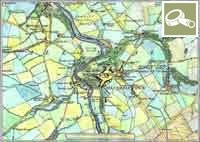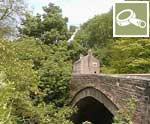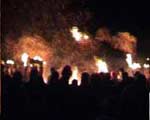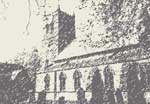ALLENDALE
Allendale—valley of the
shining water
 This
area of the North Pennines lies 800 feet above sea level and has
been designated an Area of Outstanding Natural Beauty. This
area of the North Pennines lies 800 feet above sea level and has
been designated an Area of Outstanding Natural Beauty.
The principal settlement in the dale is Allendale Town. Variously
Alwenton and Allenton in its past, is is a village of some 1,500
inhabitants lying on a bridging point in the East Allen Valley.
 View a video: Allendale and the River
View a video: Allendale and the River
The River Allen is thought to be derived from Alwent—the
Saxon for shining water. A plaque on the church testifies
to Allendale's claim to be at the geographical heart of Great Britain,
and it is said a small cottage (now ruined) in the valley just above
the village is built on the exact coordinates.
Click here
for a detailed local map.
ALLENDALE
Farming and lead mining
 Originally
a market town serving a farming area, Allendale expanded in the
nineteenth century as a lead mining centre. The mineral was mined
at Allenheads, and other locations in the dale, and smelted at Allen
Mill. Originally
a market town serving a farming area, Allendale expanded in the
nineteenth century as a lead mining centre. The mineral was mined
at Allenheads, and other locations in the dale, and smelted at Allen
Mill.
Great flues were constructed underground which directed fumes to
chimneys miles away on the fell top. This was so that lead, which
solidified on the walls of the flues as the fumes cooled, could
be scraped off and collected.
In the early twentieth century these flues and tunnels were used
by local children (including Ivy and Basil Fairlamb) who played
on old bogey carts before the rail tracks were removed. By the 1950s
this had become a more dangerous pastime as collapses became more
frequent.
Gradually the architecture of the lead industry assumed a more
romantic and dilapidated air, reclaimed by ivy, willowherb and heather.
The chimneys themselves gradually collapsed until, in the 1990s,
the more intact of the two chimneys was restored following a severe
lightning strike.
 The
population of the dale fell sharply at the end of the nineteenth
century as the lead mining industry declined. View
the graph of Allendale's population between 1800 and 2000. The
population of the dale fell sharply at the end of the nineteenth
century as the lead mining industry declined. View
the graph of Allendale's population between 1800 and 2000.
John William Hall (b.1842) wrote a memoir in the late 1920s about
his early life at High Studdon in Allendale(1).
Here he describes the life of an Allendale lead miner.
The length of the Dale is about ten miles (from
Allenheads on the south to Catton on the north) and at that time
it was thickly populated—quite unlike the present time. Lead
mining was extensive, and very prosperous, and houses were scattered
everywhere. High Studdon had three mining families, Low Studdon
six, West Studdon two, Scotch Hall ten families, [and] Sinderhope
[had] eighteen families.
Working four days a week, or even only three, a
miner was an old man at fifty: the work was so unhealthy. So,
his little farm occupied him the remaining time. The miners stood
in water up to their knees, more often than not, and the mines
were ill-ventilated. A complaint of the breathing was very common.
Boys began at the age of ten to wash the ore outside the mine.
The miners would keep two or three cows on their
land and usually each family had a fell pony. Every family, in
April or May, cut peats on the fell—each about 18 inches
long and 4 inches thick—enough for about fifty cartloads.
They were left to dry and in July, August or September the men
would lead them home and pack them in large stacks. Coals were
little known in the district in the early days, so the miners
had considerable occupation in leading twelve months supply. They
were allowed to cut their peats for nothing on the moors, and
these ponies of theirs were often called 'peat leaders'.
The miners were distinctly religious and betting
and gambling were unknown. Several fairs were held through the
year and these were a great opportunity for friendly greetings;
also for a display of horsemanship. With these spirited Galloways,
or mountain ponies, there was furious riding and all manner of
sports. As these ponies lived on the fells and went in droves,
it was not uncommon to borrow—without leave—a neighbour’s
horse and ride off to the fair before the rightful owner had reached
the fell. Mountebanks and all manner of sights could be met with
and a good deal of treating and drinking was everywhere apparent.
Today these fairs are things of the past. At Christmas they had
much feasting and had 'toffee joins' at each other’s houses.
Toffee was made from, say, one stone of black treacle and some
butter, and when cooked everyone had a share.
ALLENDALE
Country retreat
 In
the twentieth century Allendale became popular as a tourist destination
for visitors from the expanding urban region of Tyneside. In
the twentieth century Allendale became popular as a tourist destination
for visitors from the expanding urban region of Tyneside.
Arrival was on the single track railway line which ran from Hexham,
via Studdon, before the engine was turned around to make the return
trip.
Allendale Station itself was a good mile outside the village and
throughout the early years of the last century the yard was busy
with six to eight horsedrawn vehicles vying to carry people along
the Station Road into Allendale.
Ivy Fairlamb remembers traps, a landau, and Mr. Shield's 'brake
(which carried a lot of people), alongside other carriages waiting
to meet the Hexham train.
Given its reputation as a picturesque tourist destination Allendale
developed more than its fair share of pubs and hotels, most situated
around the large market square. Some still remain despite the fall
in the tourist trade from the Sixties onwards.
ALLENDALE
New Year's Eve
 Allendale
is perhaps most famous for its Tar Barl ceremony. Each New Year's
Eve a procession of flaming tar barrels and a big bonfire are held
in the town square to celebrate. Allendale
is perhaps most famous for its Tar Barl ceremony. Each New Year's
Eve a procession of flaming tar barrels and a big bonfire are held
in the town square to celebrate.
 View a video: Tar Barrels & Fire
2000/01
View a video: Tar Barrels & Fire
2000/01
The origins of the procession around the village, culminating in
the barrels being thrown on a bonfire just before midnight, is unclear.
Folklore suggests it goes back centuries and is connected with
pagan celebrations of the winter solstice. Other evidence suggests
while the fire might be a longer tradition, the tar barrels themselves
are a more recent fixture.
The history of Allendale tar barls ceremony has
always been shrouded in mystery, or fantasy, with one enthusiastic
Tynedale publicist once advertising it as the Baal Fire Ceremony!
In fact, the reverse is true, for rather than being linked to
Baal, the ancient Phoenician sun god also known as Beelzebub,
it seems that the ceremony was started by the Methodists.
The newsletter says that in 1858, some men of Allendale
singing en route to a watch night service at the Methodist Chapel
found the tallow candles used for lighting their music kept blowing
out in the high wind.
It was then suggested that a tar barl might be
set alight as a means of illumination for the music. Tar barrels
could be easily found, for Allendale was surrounded by farms,
where tar was used in sheep dipping.
from the Hexham
Courant
ALLENDALE
St Cuthbert's Church
 A
church has stood on the site since at least 1174. Orginally the
dedication was The Church of Our Lady but at some point the dedication
was changed to St Cuthbert's. A
church has stood on the site since at least 1174. Orginally the
dedication was The Church of Our Lady but at some point the dedication
was changed to St Cuthbert's.
The present structure dates only from 1873 when the previous church,
built in 1807, was pulled down.
Generations of Fairlamb family events have been celebrated at St
Cuthbert's, and the family has long had a tradition of serving in
a lay capacity as churchwardens and bellringers.
The Fairlambs of the late eighteenth and nineteenth century were
often joiners. They secured the contract to supply much of the woodwork
seen inside the present church.
The parish church of St. Cuthbert, which
was rebuilt in 1807, is to be replaced in 1873 by a handsome structure;
it will be in the Geometrical Pointed style, and consist of nave,
aisles, and chancel, and north and south chancel aisles, and will
contain a beautiful font, to be presented by Mrs. George Arnison
in memory of an infant son.
The designs for the erection of the edifice
are by Messrs. Austin and Johnson, of Newcastle; the contractors
for the masonry, Peter Laing and Sons; and for the woodwork, the
Messrs. Fairlamb, of Allendale: the cost of the building is to
be about £1,500, collected by the present rector.
The register dates from the year 1662. The
living is a rectory, yearly value £300, in the gift of the
lord of the manor, and held by the Rev. Titus Emerson, of University
College, Durham.
Kelly's Directory of Northumberland
and Durham (1873), p. 484
ALLENDALE
The fallen of the Great War
 Click here to learn more
about the men who died in the Great War and are commemorated on
Allendale lych gate.
Click here to learn more
about the men who died in the Great War and are commemorated on
Allendale lych gate.
ALLENDALE
The Allendale dialect
Allendale had its own distinctive dialect which is disappearing
due to the social changes of the late twentieth century.
 Listen
to Basil Fairlamb (b.1907) talk about an exhibition of side-saddle
riding at Allendale Agricultural Show (recorded 1980). Listen
to Basil Fairlamb (b.1907) talk about an exhibition of side-saddle
riding at Allendale Agricultural Show (recorded 1980).
 Follow
this link to listen to George Sparks (b.1898) talk about the
merging of mineworkers smallholdings into farms such as Byerhope
(recorded 1955). The British Museum, through the
Collect Britain website, has made a range of northern dialect
recordings available online.
Follow
this link to listen to George Sparks (b.1898) talk about the
merging of mineworkers smallholdings into farms such as Byerhope
(recorded 1955). The British Museum, through the
Collect Britain website, has made a range of northern dialect
recordings available online.
ALLENDALE
John Wesley & Methodism
 Local
folklore has it that Wesley preached in a glade down the Dene, close
to where the Philipburn and the Allen meet. Local
folklore has it that Wesley preached in a glade down the Dene, close
to where the Philipburn and the Allen meet.
Methodism secured a place in the Allen valley in 1823.
One day two strangers appeared in Allenheads, and began to sing
about being soldiers of Christ.
The young men employed in washing lead ore rushed from their work
to hear the strange men, and many of the mothers, thinking the newcomers
were recruiting sergeants, whose object was to get their sons enlisted
into the King's Army, with more force than politeness ordered the
strangers to be ‘off about their business’.
Friday 29 July 1748
At noon I went to the Cross in Allandale town,
where Mr. Topping, with a company of the better sort, waited for
us. I soon found it was but a vain attempt to dispute or reason
with him.
He skipped so from one point to another, that it
was not possible to keep up with him: So after a few minutes I
removed about an hundred yards, and preached in peace to a very
large congregation; it being the general payday, which is but
once in six months.
John Wesley
Most Allendale folk, and the Fairlambs, were strong High Anglicans,
whom frustrated Methodists referred to as despotic agents of
high churchism.
In Allendale Town services were first conducted in a heckler's
shop (a branch of business long since extinct), and there the nucleus
was formed of what afterwards developed into a numerous society.
As elsewhere, cottages, barns, workshops were the initial homes
of the societies in Allendale, later chapels were built in Allendale
and elsewhere in the Dale.
There is
a story about a local brass band which Mr. Wild tells with enthusiasm.
The members of it had decided to go into the street to drown the
processionists (Methodists).
The noise produced by the bandsmen and the singers
was tremendous, the excitement indescribable; all the people in
the little town seemed to be in the street.
In the Contest the band utterly failed, and the
processionists sang lustily to the chapel, where a glorious meeting
was held. The bandsmen retired to a public-house, with a sense
of humiliation, several members declaring that that was their
last night in the band.
Northern Primitive Methodism by
WM Patterson, E Dalton (London 1909), p171-83
|

